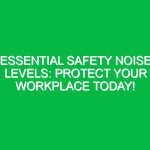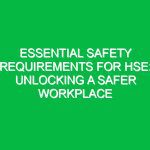Welcome to Our Toolbox Talk
Hello team! Thank you for gathering today for our toolbox talk. Today, we’ll be discussing an incredibly important topic: COVID-19 & Other Communicable Diseases within the Health, Safety, and Environment (HSE) domain. As we continue our daily operations, understanding how to protect ourselves and each other from communicable diseases is crucial to maintaining a safe and healthy workplace.
The Importance of Understanding COVID-19 & Other Communicable Diseases
In recent years, we have witnessed the profound impact of COVID-19 on our lives and the workplace. This virus, along with other communicable diseases, poses significant risks not just to individual health but also to our collective Safety and productivity. Awareness and proactive measures are essential to minimize these risks.
Communicable diseases can spread quickly in environments where people work closely together. Understanding how these diseases transmit and implementing effective strategies can help us prevent outbreaks that disrupt work and compromise health.
What Are Communicable Diseases?
Communicable diseases are illnesses caused by pathogens, such as bacteria, viruses, and parasites, that can be transmitted from one person to another. Examples include:
- COVID-19
- Influenza
- Tuberculosis
- HIV/AIDS
- Norovirus
How Does COVID-19 Spread?
COVID-19 primarily spreads through respiratory droplets when an infected person coughs, sneezes, or talks. It can also spread by touching surfaces contaminated with the virus and then touching the face. Understanding these transmission methods is key in preventing the spread of the virus.
Key Procedures to Prevent the Spread of COVID-19 & Other Communicable Diseases
1. Personal Hygiene
One of the simplest yet most effective strategies to prevent the spread of communicable diseases is practicing good personal hygiene. Here are some essential hygiene practices:
- Wash your hands frequently: Use soap and water for at least 20 seconds, especially after being in public places or after coughing and sneezing.
- Use hand sanitizer: When soap and water are not available, use a hand sanitizer that contains at least 60% alcohol.
- Avoid touching your face: This reduces the risk of transferring pathogens from your hands to your eyes, nose, or mouth.
2. Respiratory Etiquette
Practicing good respiratory etiquette can significantly reduce the spread of viruses. Remember to:
- Cough or sneeze into a tissue: Dispose of the tissue immediately.
- If you don’t have a tissue: Cough or sneeze into your elbow, not your hands.
- Wear a mask: Masks can help prevent the spread of respiratory droplets, especially in crowded or enclosed spaces.
3. Social Distancing
Maintaining a safe distance from others can reduce the risk of airborne transmission. Aim to keep at least six feet away from colleagues when possible. This is particularly important in common areas like break rooms or meeting spaces.
4. Cleaning and Disinfection
Regular cleaning and disinfection of shared surfaces is critical. Here’s how to do it effectively:
- Identify high-touch surfaces: These include doorknobs, light switches, and communal equipment.
- Use appropriate disinfectants: Ensure that the products used are effective against COVID-19 and other pathogens.
- Establish a cleaning schedule: Regular cleaning should be part of our daily routine.
Recognizing Symptoms
It’s essential to be aware of the symptoms of COVID-19 and other communicable diseases. Common symptoms include:
- Fever or chills
- Cough
- Shortness of breath or difficulty breathing
- Fatigue
- Muscle or body aches
- New loss of taste or smell
- Sore throat
- Congestion or runny nose
- Nausea or vomiting
- Diarrhea
If you or someone you know is experiencing these symptoms, it’s crucial to stay home, seek medical advice, and follow isolation protocols.
Open Communication and Reporting
Encouraging open communication about health concerns is paramount. If you feel unwell or have been in contact with someone who tested positive for COVID-19, please report this to your supervisor immediately. This allows us to take necessary Precautions to protect everyone in the workplace.
Regulations and Standards
Compliance with local health Regulations and company policies regarding COVID-19 & Other Communicable Diseases is not just a legal obligation; it’s a moral one. Understanding these regulations helps us ensure a safe work environment. Some key regulations may include:
- Occupational Safety and Health Administration (OSHA) guidelines
- Centers for Disease Control and Prevention (CDC) recommendations
- Local health department mandates
Non-compliance can lead to legal actions and impacts on our Workplace Safety. It’s crucial that we all understand and adhere to these regulations.
Real-Life Scenarios
Let’s consider a hypothetical scenario. Imagine a team member, Alex, comes to work feeling slightly unwell but decides to push through. During the day, Alex interacts with several colleagues and uses shared equipment. Later, Alex tests positive for COVID-19, and several coworkers begin to show symptoms. This situation could have been prevented if Alex had communicated health concerns and stayed home. It’s a reminder for all of us that our health impacts the health of our colleagues.
Best Practices Moving Forward
As we move forward, here are some Best Practices to adopt in our daily routines:
- Stay informed: Keep up with updates about COVID-19 and other communicable diseases from reliable sources.
- Participate in Training: Engage in any available training sessions on health and Safety practices.
- Encourage each other: Remind your colleagues to follow safety protocols.
Engagement and Discussion
Now, I’d like to open the floor for discussion. What steps do you think we can take to improve our Workplace Safety regarding communicable diseases? Are there any concerns you would like to share? Your input is invaluable in creating a safer work environment for everyone.
Conclusion
In conclusion, our understanding and proactive measures regarding COVID-19 & Other Communicable Diseases are vital to maintaining a safe workplace. By practicing proper hygiene, engaging in open communication, and adhering to regulations, we can protect ourselves and our colleagues. Thank you for your attention and commitment to safety. Together, we can ensure a healthier work environment for all.


